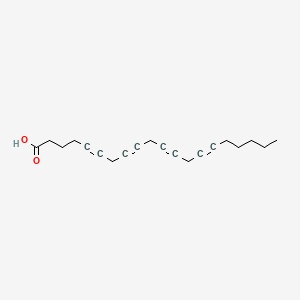| Messina EJ et al. |
Prostaglandins and local circulatory control. |
1976 |
Fed. Proc. |
pmid:786740
|
| Murphy E et al. |
Role of lipoxygenase metabolites in ischemic preconditioning. |
1995 |
Circ. Res. |
pmid:7859391
|
| Anderson KM et al. |
The selective 5-lipoxygenase inhibitor A63162 reduces PC3 proliferation and initiates morphologic changes consistent with secretion. |
1994 Sep-Oct |
Anticancer Res. |
pmid:7847833
|
| Anderson KM et al. |
Spontaneous chemiluminescence of ETYA (5,8,11,14-eicosatetraynoic acid) is inhibited by catalase or peroxidase. |
1994 |
Prostaglandins Leukot. Essent. Fatty Acids |
pmid:7846095
|
| Liminga M et al. |
Lipoxygenases in corneal epithelia of man and cynomolgus monkey. |
1994 |
Exp. Eye Res. |
pmid:7821376
|
| Gan QF et al. |
Identification of a specific methionine in mammalian 15-lipoxygenase which is oxygenated by the enzyme product 13-HPODE: dissociation of sulfoxide formation from self-inactivation. |
1995 |
Biochemistry |
pmid:7766617
|
| Tollet P et al. |
Growth hormone signaling leading to CYP2C12 gene expression in rat hepatocytes involves phospholipase A2. |
1995 |
J. Biol. Chem. |
pmid:7759504
|
| Vazquez B et al. |
Arachidonic acid metabolism modulates vasopressin-induced renal vasoconstriction. |
1995 |
Life Sci. |
pmid:7752810
|
| Alonso MJ et al. |
Nitric-oxide-related and non-related mechanisms in the acetylcholine-evoked relaxations in cat femoral arteries. |
1993 Nov-Dec |
J. Vasc. Res. |
pmid:7694666
|
| López S et al. |
Interleukin-1 increases 15-hydroxyeicosatetraenoic acid formation in cultured human endothelial cells. |
1993 |
Biochim. Biophys. Acta |
pmid:7691182
|
| O'Donnell VB and Azzi A |
Role of oxidants in TNF-alpha-mediated cytotoxicity. |
1995 |
Biochem. Soc. Trans. |
pmid:7672259
|
| Vu-Dac N et al. |
Fibrates increase human apolipoprotein A-II expression through activation of the peroxisome proliferator-activated receptor. |
1995 |
J. Clin. Invest. |
pmid:7635967
|
| Sullivan TJ and Parker CW |
Possible role of arachidonic acid and its metabolites in mediator release from rat mast cells. |
1979 |
J. Immunol. |
pmid:762430
|
| van de Sandt JJ et al. |
Release of arachidonic and linoleic acid metabolites in skin organ cultures as characteristics of in vitro skin irritancy. |
1995 |
Fundam Appl Toxicol |
pmid:7601324
|
| Wijkander J et al. |
5-Lipoxygenase products modulate the activity of the 85-kDa phospholipase A2 in human neutrophils. |
1995 |
J. Biol. Chem. |
pmid:7592874
|
| Meier RW et al. |
Inhibition of the arachidonic acid pathway prevents induction of IL-8 mRNA by phorbol ester and changes the release of IL-8 from HL 60 cells: differential inhibition of induced expression of IL-8, TNF-alpha, IL-1 alpha, and IL-1 beta. |
1995 |
J. Cell. Physiol. |
pmid:7559807
|
| Wu Z et al. |
Conditional ectopic expression of C/EBP beta in NIH-3T3 cells induces PPAR gamma and stimulates adipogenesis. |
1995 |
Genes Dev. |
pmid:7557387
|
| Nagao T et al. |
Ca(2+)-independent fusion of secretory granules with phospholipase A2-treated plasma membranes in vitro. |
1995 |
Biochem. J. |
pmid:7537492
|
| Chaudry AA et al. |
Arachidonic acid metabolism in benign and malignant prostatic tissue in vitro: effects of fatty acids and cyclooxygenase inhibitors. |
1994 |
Int. J. Cancer |
pmid:7512536
|
| Teboul L et al. |
Thiazolidinediones and fatty acids convert myogenic cells into adipose-like cells. |
1995 |
J. Biol. Chem. |
pmid:7499310
|
